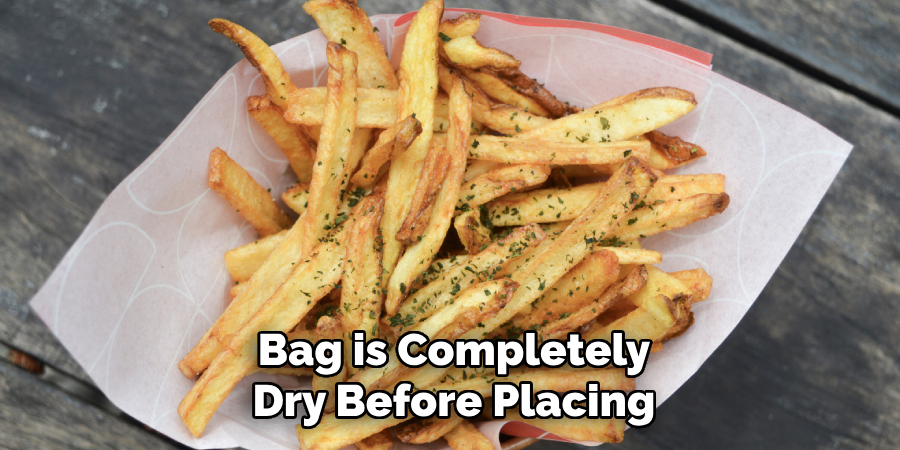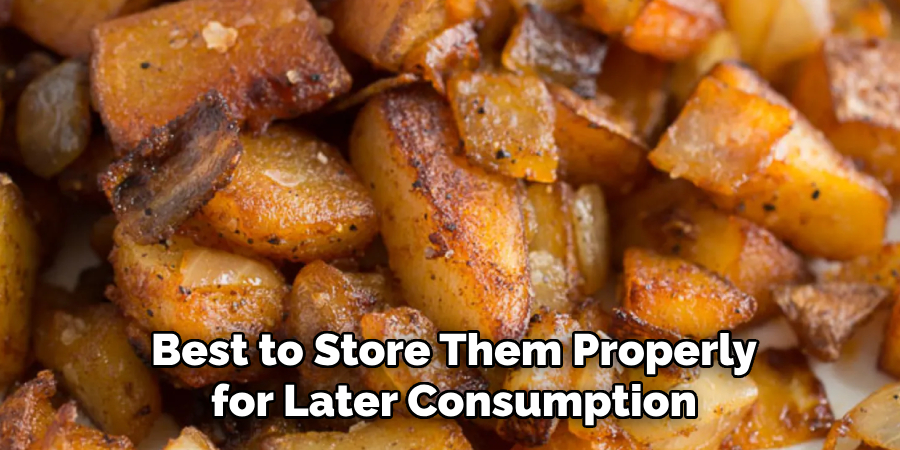French fries are a beloved snack or side dish, but their crisp texture and irresistible flavor can quickly diminish if not stored properly. Whether you have leftover fries from a meal or you’re preparing them in advance, knowing the right methods to store and reheat them ensures you can enjoy their delicious taste later.
This guide on how to store fries will walk you through the best practices for keeping your fries fresh and appetizing.

Why is Proper Storage Important?
Properly storing fries helps preserve their texture and flavor. Exposure to air, moisture, and heat can cause the fries to become soggy and lose their crispiness. In addition, leaving them out at room temperature for too long increases the risk of bacteria growth, which can lead to food poisoning.
By storing fries in the right way, you can maintain their delicious taste and avoid any potential health hazards.
Needed Materials
Airtight Container or Ziplock Bag:
The key to storing fries is keeping them away from air and moisture. An airtight container or ziplock bag will prevent air and humidity from reaching the fries, preserving their texture and flavor.
Paper Towels:
Paper towels are essential for removing excess oil from the fries before storing them. Oil can cause sogginess if left in contact with the fries for too long.
Freezer:
If you plan on freezing your fries, make sure you have enough space in your freezer to accommodate the airtight containers or ziplock bags.
9 Step-by-step Guides on How to Store Fries
Step 1: Allow the Fries to Cool
Before storing your fries, allow them to cool completely at room temperature. Placing hot fries directly into an airtight container or bag can trap steam, leading to sogginess and a loss of texture. Spread the fries on a plate or tray in a single layer to ensure they cool evenly. Avoid letting them sit out for more than two hours to prevent any risk of bacteria growth.
You can speed up the cooling process by placing the fries in the refrigerator for a few minutes. If you’re in a hurry, put them in the freezer for a couple of minutes, but make sure they don’t freeze completely.
Step 2: Remove Excess Oil
Once the fries have cooled, use paper towels to gently blot away any excess oil. This step is crucial to prevent the fries from becoming greasy or soggy while in storage. Lay the fries on a clean sheet of paper towel and pat them lightly to absorb as much oil as possible. Removing the oil not only helps maintain their texture but also enhances their flavor when reheated later.
The best time to remove excess oil is when the fries are still warm. This makes the oil easier to absorb, and it will prevent any sticking while you’re removing them from the paper towels.

Step 3: Choose Your Storage Method
Once the fries are cooled and excess oil has been removed, it’s time to select the appropriate storage method based on when you plan to eat them. If you intend to consume the fries within a day, storing them in the refrigerator is sufficient. Place the fries into an airtight container or ziplock bag and ensure they are sealed tightly to prevent exposure to air and moisture. For longer storage, consider freezing the fries.
Arrange them in a single layer on a baking sheet lined with parchment paper and freeze for about an hour to ensure they don’t stick together. Once frozen, transfer the fries to an airtight container or ziplock bag before placing them back in the freezer. These methods will help retain their quality and taste until you’re ready to reheat and enjoy them.
Step 4: Label and Date
If you are storing the fries for later use, especially in the freezer, it is important to label and date the container or ziplock bag. Use a marker or adhesive label to note the date of storage. This step helps you keep track of freshness and ensures you consume the fries within an optimal time frame.
Fries stored in the refrigerator should ideally be consumed within 1 to 2 days, while frozen fries can last up to a month. Proper labeling also prevents confusion and helps you avoid keeping the fries for too long, which could compromise their taste and quality.
Step 5: Keep Fries Away From Moisture
Moisture is one of the biggest culprits when it comes to soggy fries, so it’s essential to keep them as dry as possible during storage. Ensure the storage container or ziplock bag is completely dry before placing the fries inside. Avoid storing fries with other foods that might release moisture, such as fruits or vegetables.

If you’re freezing the fries, the initial step of freezing them in a single layer on a baking sheet will ensure that any residual moisture is minimized before transferring them to their final storage container. Keeping the fries away from moisture will help preserve their crispness and make them enjoyable to eat when reheated.
Step 6: Store the Fries in the Right Place
Proper storage also means keeping fries in a cool, dry place. Avoid storing them near any heat sources or in direct sunlight, as this can cause them to lose their crispness and become soggy. The refrigerator is an ideal environment for short-term storage, while the freezer works best for longer periods. Make sure your fridge is set at 40°F (4°C) or below and your freezer at 0°F (-18°C) or lower.
It’s also crucial to avoid opening the fridge or freezer frequently, as this can cause temperature fluctuations and impact the quality of the fries. If possible, store the fries in an area where they won’t be disturbed until you’re ready to eat them.
Step 7: Reheat the Fries Properly
When you’re ready to enjoy your stored fries, it’s important to reheat them properly to maintain their texture and flavor. For refrigerated fries, preheat your oven to 375°F (190°C) and place the fries on a baking sheet lined with parchment paper. Bake for about 10-15 minutes until they are crispy and heated through.
For frozen fries, preheat your oven to 425°F (220°C) and bake for 20-25 minutes, turning them halfway through cooking to ensure even heating. You can also use an air fryer or microwave, but these methods may not result in as crispy of fries. Avoid reheating the fries in a pan or skillet, as they may become too greasy.
Step 8: Add Seasoning
If you want to add some extra flavor to your stored fries, you can do so before or after reheating. Before storing them, consider adding seasonings such as herbs, spices, or grated cheese to the fries for extra flavor when they are reheated. You can also sprinkle seasoning on top of the hot fries after reheating for a burst of flavor.

If you plan to dip the fries in ketchup or other sauces, make sure to serve them on the side rather than pouring it over the fries. This will prevent them from becoming soggy and allow you to enjoy their crispness.
Step 9: Enjoy Your Stored Fries!
With these simple steps, you can now store your fries properly and enjoy them at any time without sacrificing their quality and taste. Whether you have leftover homemade fries or bought them from a restaurant, these storage methods will help you save any extra fries for later consumption.
Just make sure to remove any excess oil, choose the right storage method based on your timeframe, label, and date the container, keep the fries away from moisture, store them in a cool place, reheat them properly, and add seasoning if desired. Now, go ahead and enjoy your perfectly stored fries! Happy snacking!
Frequently Asked Questions
Q1: Can I Store Fries in the Fridge or Freezer Without Removing Excess Oil?
A1: It is recommended to remove excess oil before storing fries to prevent sogginess and sticking. However, if you are short on time, you can store them in the fridge or freezer without removing excess oil. Just make sure to drain any excess oil before reheating.
Q2: Can I Reheat Fries in the Microwave?
A2: While you can reheat fries in the microwave, it may not result in crispy fries. It is best to use the oven or an air fryer for crispier results. The microwave can be used for a quick reheat, but it is recommended to use the oven or air fryer for better texture.
Q3: How Long Can I Keep Fries in the Freezer?
A3: Frozen fries can last up to a month if stored properly. However, for optimal taste and quality, it is recommended to consume them within 1-2 weeks. Make sure to label and date the container before storing them in the freezer.
Q4: Can I Reheat Fries More Than Once?
A4: It is not recommended to reheat fries more than once. Reheating them multiple times can result in a loss of texture and flavor. If you have leftovers, it is best to store them properly for later consumption.

Conclusion
Properly storing and reheating fries ensures that you can enjoy them without compromising their taste, texture, or quality. By following these simple yet effective steps on how to store fries, you can prevent sogginess, maintain their crispness, and even enhance their flavor with added seasoning.
Whether you’re storing them short-term in the refrigerator or longer-term in the freezer, taking the right precautions will make leftover fries just as satisfying as when they were first made. With the guidelines provided, you can confidently store and savor your fries whenever the craving strikes. Happy snacking!
Professional Focus
Angela Ervin, a former interior designer turned blogger, specializes in kitchen design and renovations. Through her website, she blends her passion for cooking with design expertise, sharing practical and creative ideas. Known for balancing functionality and beauty, Angela’s insightful content has made her a trusted voice in home design and lifestyle.
About the Author
Angela Ervin, an experienced interior designer and blogger, combines her passion for kitchen renovations with storytelling. Living in Petersburg with her family, she enjoys cooking and testing her projects firsthand. Known for her humor and relatable style, Angela shares creative, functional design insights through her content, making her a trusted voice in home design.
Education History
University: Virginia Commonwealth University
Degree: Bachelor of Fine Arts (BFA) in Interior Design
- Angela’s education at VCU focused on mastering core interior design principles, including spatial planning, color theory, materials selection, and sustainable design practices.
- She gained hands-on experience through studio projects and collaborative design exercises, which honed her ability to create functional and aesthetically pleasing environments.
- Her coursework also emphasized problem-solving and practical applications of design, preparing her for real-world projects like her self-directed kitchen renovations.
- The program’s strong foundation in both technical skills and creative expression shaped Angela’s ability to seamlessly integrate form and function in her work.


